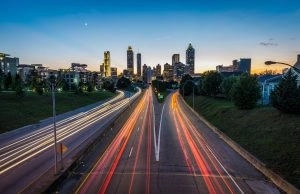Sustainable Public Transport: Is it Possible? with Gareth Dennis of Permanent Rail Engineering
As more and more cities, most recently Houston, urge its citizens to carpool to help with congestion, accidents and pollution, we decided to sit down with a MarketScale Transportation Podcast frequenter, Gareth Dennis of Permanent Rail Engineering, to get his take on this worldwide trend. Gareth, an engineer and writer, joined us to talk about the growth of active travel (and what that means), how public transit is evolving, and how the UK compares to the US in terms of transit and carpooling.
Elmer Guardado: It seems like you’re in an interesting niche where you do have to understand multiple angles of the situation, right? Like you said the engineering side, but the social side of how do people and why do people transport the way they do. So what are some of the difficulties that come with trying to get these concepts from different sides of different industries across? 
Gareth Dennis: Yeah. So I mean I can go with two angles for this. One of them is sort of the understanding why people takes certain transport modes and that can be quite difficult to understand and actually collecting data about how many people actually take certain transport modes can be difficult in itself. So actually, collecting survey data to understand who travels on what transport mode can be quite tricky but would be adventive kind of more data, more big data and more open licenses for a data that comes a little bit easier. People using their phones for example is a really useful way to get that information. So people have their WiFi switched on their phone normally and transport for London, which is the kind of group that run transportation in London, so the underground and some of the other trains, they actually had a trial for a while collecting data from people’s WiFi on their phones and tracing them through the transport network and out other side. And it was all anonymous, but it started giving these heat maps of kind of the flow of people through a city.
So kind of that side of things can be quite tricky, getting that information, and then understanding how it’s relevant. The other side is when I’m doing more detailed design is actually for example at platforms, at railway station platforms, you have this sort of conundrum of the trains need to be as far away from the platform as possible so they don’t hit the platform obviously as they go pass. At the same time, so that people can easily get on and off the train, you want the train to be as close to the platform as possible. So there’s this sort of strange dichotomy of keeping the trains far away and close as possible. And the way that people interact with trains so the ergonomics, the way that people kind of cluster around on station platforms, understanding that and that’s kind of quite social side of things is really important to manage the safety at that interface because it’s actually quite a dangerous place to be at the edge of a platform.
 So yeah, those are two sides of kind of… as a civil and a mechanical engineer, you wouldn’t necessarily expect to be involved in the social and ergonomic side of things and the behavioral side of things quite as much.
So yeah, those are two sides of kind of… as a civil and a mechanical engineer, you wouldn’t necessarily expect to be involved in the social and ergonomic side of things and the behavioral side of things quite as much.
Elmer Guardado: Yeah, that’s fascinating and I think that that platform example is perfect because it points out that dichotomy and it’s kind of interesting that there aren’t many other fields that would really expect you to think about both sides of that. So that’s super interesting. So with permanent rail engineering and the consulting you’re doing, what kind of companies or clients do you find yourself working with?
Gareth Dennis: So the majority of the time I spent myself working for Network Rail, they’re kind of the custodians, the infrastructure manager for the mainline railways in the United Kingdom. So almost all the railways in the UK are owned by Network Rail, it’s a company, but it’s also sort of a government body. So the track really is owned by the government. So most of the projects we do are for this company, Network Rail, and there’s a few strange stats about Network Rail.
So they happen to be the biggest builder of bridges in the world. There are so many bridges on the rail network in the UK, it’s the oldest railway network in the world, so there are lots of bridges and so many of these have to get renewed because some of them are reaching 200 years old. Every now and then they have to get renewed, so imagine that’s happening across a network of 7,000 kilometers or more. That’s a lot of bridges that get renewed a year, which is why they have these roles, they’re kind of the biggest bridge builder in the world which is quite a cool fact, but they do. 
So there’s a huge amount of work to be done for Network Rail. But also we do work for the train operating companies in the UK so that’s the company that actually run passenger services and freight services. They often wanted to introduce new trains, and so to fit those trains on to the track, we have go through a process called “Clearance Analysis” or “Gauging” which basically fitting trains. It’s almost like square peg round hole, particularly with the container freight. You’ve got a square box that you have to get through old arch bridges that were built by Stevenson 170 years ago. That can be quite fun.
So yeah, the things like these that keeps it interesting. I enjoy working with the various different companies and the different demand is quite fun.
Elmer Guardado: So then in regards to both of these different regions, the US and the UK, do you feel like they’re pretty much on par then in regard to this problem?
Gareth Dennis: So both the US and the UK invest in sort of kind of government initiatives to increase carpooling. There’s a city near me called Leeds. Leeds has carpool lanes or car sharing lanes. The technical name is the High Occupancy Vehicle Lane basically. There’s a little sign with like some little sort of stick figures in the car saying, “If you’ve got more than one person in the car, you’re allowed to drive in this lane.” And the US has exactly the same and there are kind of sponsored initiatives to support more people, sort of some companies support car sharing. 
So I know that in the US it’s about 10%. I don’t actually have the figures for the UK unfortunately, so I can’t give you an exact comparison, but both countries are investing in supporting carpooling, kind of car sharing as an option. The challenge of course is that coupled with this desire to have more people car sharing is the fact that we’re all working more, we’re working different sorts of hours, the traditional 9:00 to 5:00 is breaking down. And so if you have lots of people working different workings hours or longer working hours, the opportunity to carpool for commuting reduces a bit.
So there are these pressures that have changed the landscape a bit. On the other hand, the advent of smartphones and GPS on everyone’s phones and kind of app culture, again, makes it a bit easier. So that allows you to quite easily find someone else who might be making the same journey. So the technology is sort of kind of moving things forward while sort of working patterns pull it back again. So it’s kind of been bouncing around the 10% mark for quite a few years now.
Elmer Guardado: I mean it’s good to see that at least both regions are acknowledging it as a problem, right? What do you see looking ahead into the horizon, what do you see as something that could potentially make this whole situation a little smoother? In the little pre-interview survey, you mentioned something you call the growth of active travel, can you talk about that a little bit?
Gareth Dennis: Yeah. This for me is really important. It ties back to sustainable travel more generally which I consider to be public transport, so that’s rail, buses, trams, these sorts of things. They don’t have the answer because they can’t go to everyone’s front door. But if you make public transport good enough that they do most of the journey for most people, then active travel really covers walking, cycling, people are in wheelchairs, basically moving under your own steam. Now in the UK, we have the advantage that cities are smaller, distances are easier to walk, and also we have a lot of… in the center of cities actually, it’s quite hard for cars to move so there are lots of kind of pedestrian areas. It’s a little bit easier for us.
 In the US, you have huge cities that are spread over massive distances and so active travel is much harder in the US cities because of that and also in quite a few cities, actually the space for pavements and cycle lanes that they don’t exist or they’ve been gradually kind of taken over by the car. So the challenge is making the space for active travel for people to walk and cycle. But cycling is an interesting one. So we’ve talked about how many people per hour per direction you can get in a bus or in a car share. So kind of decent capacity road you can get between 2,000 and 4,000 people moving.
In the US, you have huge cities that are spread over massive distances and so active travel is much harder in the US cities because of that and also in quite a few cities, actually the space for pavements and cycle lanes that they don’t exist or they’ve been gradually kind of taken over by the car. So the challenge is making the space for active travel for people to walk and cycle. But cycling is an interesting one. So we’ve talked about how many people per hour per direction you can get in a bus or in a car share. So kind of decent capacity road you can get between 2,000 and 4,000 people moving.
For the same width of lane, for cyclists, you can move 14,000 people per hour per direction. So it’s not like it’s just a nice environmental, “Oh, it’s nice for the green lobby to get people cycling.” It’s an economic necessity for cities to build cycling infrastructure. And you can look at the health across Europe, particularly Mainland Europe, countries like the Netherlands, Germany, France where they invest a lot in cycling infrastructure, the health of the people in the city improves because the air quality improves, less traffic, better air quality and people are a bit fitter from cycling as well which helps.
It’s better for society generally if more people are moving under their own steam to get to from work or their house, but everything has to fit together. The public transport has to be right. It has to cost the right amount. And coupled with that, I know a major challenge in the US and to an extent the UK as well is how cheap fuel is. That makes a big difference. So fuel in the US is very cheap and in the UK we’ve had a freeze on kind of increase of fuel costs for nearly eight years now. This means that it’s difficult for public transport to compete when essentially it gets cheaper every year for people to drive around. 
So there’s kind of a holistic sort of view on what this is going to do in the future and whether people are going to move towards active travel rather than continue to drive because ultimately the best to way reduce congestion on the roads is to have fewer cars.
For the latest news, videos, and podcasts in the Transportation Industry, be sure to subscribe to our industry publication.
Follow us on social media for the latest updates in B2B!
Twitter – @TransportMKSL
Facebook – facebook.com/marketscale
LinkedIn – linkedin.com/company/marketscale








